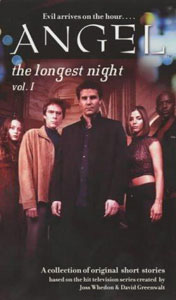It’d be cool to read an “Angel” book of 12 short stories that each take place in one hour on the longest night of the year. “The Longest Night” (December 2002), unfortunately, isn’t that book. It claims to be that book on the back cover blurb, but the editors never told the writers. So the gang can be beat up or covered in demon goo the end of one hour and healthy and clean at the start of the next, for example.
That inexcusable sloppiness makes “The Longest Night” hard to forgive, but read as individual stories with no connection, there’s some OK stuff included. Here are my rankings of the 12 short stories, all supposedly set on the night of Dec. 21-22, 2001, during Season 3:
1. “I Still Believe” by Christopher Golden – Golden piles on the Christmas schmaltz (that’s a compliment) as Cordelia helps Angel pick out gifts for Wesley, Gunn and Fred. He plays dumb, but ends the trip with the perfect gift for Cordy: a meeting with a legendary actress, whom he knew from back in the day. Really, Cordy should’ve known Angel is a great gift-giver (Claddagh ring); it’s Angelus who isn’t so good at it (dead tropical fish).
2. “Generous Presence” by Yvonne Navarro – This one is enjoyably simple: The gang gets a box of gifts from Wolfram & Hart’s Lilah Morgan. Even as they worry about Lilah’s true motives, each gift says a little something about what the lawyer thinks of the Angel Investigations members. Navarro wonderfully captures the suspense of what’s under the wrapping paper.
3. “Icicle Memories” by Navarro — This is exactly the type of yarn that works well in this format: It’s small – set mostly in the Hyperion Hotel basement — but it means a lot to the characters. A snowman monster freezes our heroes and they each think back to warm memories about ideal Christmases. Giving it the requisite bittersweet “Angel” touch, most of the memories (such as Wesley’s happy time with his family) aren’t real.
4. “It Can Happen to You” by Scott and Denise Ciencin – This kinda fun, kinda melancholy romp finds ghosts dragging an initially unwitting Wesley around L.A. to their old stomping grounds. A letter from Wesley’s dad provides a page-turning element, but it goes on a bit too long after we learn the ghosts are joyriders more so than scary threats.
5. “The House Where Death Stood Still” by Pierce Askegren – This story about a dying man who magically stops time to spend more time with his son has some poignancy to it, and Angel dressing as Santa is a nice holiday touch. But although I could see this being a standalone Season 1 episode, I could also see where the plot was going the whole way.
6. “A Joyful Noise” by Jeff Mariotte – Mariotte is a top-shelf “Angel” writer, but here he seems to be throwing an idea against the wall, and it doesn’t stick. Too much exposition is needed to explain the villains’ convoluted plan of ringing bells in a sequence that functions as a magic spell. Their goal is so over-the-top it’s humorous: An Earth-gobbling monster will emerge through a portal in the sky. A party sequence with supporting characters like Virginia and David is enjoyable, although it has no impact on the overall story.

7. “Yoke of the Soul” by Doranna Durgin – The most memorable part of this story is the trap Angel finds himself in, along with an unlucky caroler. It’s reminiscent of the “Alien” films, as he’s plastered to a wall by a viscous substance. If he moves too much, he gets knocked out, but if he doesn’t move, he can’t escape. The fact that he insists on going on this mission alone is more of a Season 2 Angel thing, and it doesn’t fit with the surrounding stories where he’s a team player. (None of these stories fit with each other, but this one is notably jarring.)
8. “Have Gunn, Will Travel” by Nancy Holder – Usually Holder’s Buffyverse stories are so large in scope that they can’t be confused with a TV episode, but this one feels like a TV pitch: The gang, particularly Gunn (a dead ringer for a foreign noble), goes on an undercover mission. While it’d be fun to see J. August Richards play dual roles, and to see Cordy and Fred in their fancy dresses, it doesn’t work as well on the page.
9. “The Anchoress” by Holder – In contrast to Holder’s other entry, this one is too ambitious for the short-story format. While time travel would later feature in the Season 9 comics and is therefore a canonical concept in the Buffyverse, here it is underexplained how modern and ancient villains communicate to set up this scheme. At any rate, our heroes end up in an old-time Europe reminiscent of Pylea. Holder delivers a vivid description of burning at the stake, and the threat of being trapped in the past when the portal closes is a high stake. “The Anchoress” is too long, but oddly needs to be more fleshed out. And it’s the worst fit with the “all in one night” concept, as Wesley is seriously ill (and then perfectly fine in the next hour).
10. “The Sun Child” by Christie Golden – In what is a weirdly common problem in “Angel” stories (see the final arc of Season 4), the Sun is threatened with permanent disappearance. In this story, the Sun is represented by a baby who is actually the Sun god, who is hunted by demons. For some reason, there’s a lot of prose about how beautiful the baby’s protector is.
11. “Bummed Out” by Durgin – Durgin peppers in some Christmastime chill as the gang huddles on the streets on an undercover mission. But ultimately the idea of demons posing as both people and objects in order to infiltrate and kill homeless people doesn’t make sense, and the massive fight scenes feel rote.
12. “Model Behavior” by Emily Oz – Cordy is invited to a gala featuring L.A.’s hottest models and their mega-successful agent. Everyone behaves toward newcomer Cordy as rudely as we’d expect, and in a nutshell, the gang tries to figure out who among this group is an evil demon. By the time I finished the book, this is the story I remembered least.
Click here for an index of all of John’s “Buffy” and “Angel” reviews.

